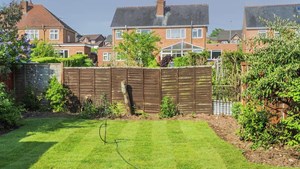How do I find out the boundaries of my property?
6 minute read

You may not have previously thought about where your property boundaries are or which fences belong to you, but knowing this information could be of assistance should you ever need to claim on your home insurance.

Get Home Insurance
Age Co helps homeowners over 50 find the right protection. We are 100% owned by Age UK and our profits go back to the charity.
How do I find my property boundaries?
There may not be an exact record of which fences or other boundary features, such as walls, hedges or ditches, belong to neighbouring properties. However, you should be able to see boundary lines plotted on your property's title plan.
What is a title plan?
A title plan is a map that’s produced by HM Land Registry that shows the rough boundary of a property, outlining it in red on Ordnance Survey maps of the area.
Under Rule 5 of the Land Registrations Rules 2003, HM Land Registry is required to provide a title plan upon the purchase of a property. These are now created electronically, however for very old properties, these may also be provided in paper form.
These plans are not supposed to be exact. They are used to show a general boundary and don’t often include very small details, such as a bay window jutting out.
What to do if you cannot find your title plan
If you cannot find your original title plan from when you purchased your property, you can pay for a copy using the HM Land Registry’s Find a Property service. All you need is your address and a form of payment. Copies usually cost around £3.
Boundary issues you might encounter
You can use the title plan to settle any questions you or a neighbour may have. Common reasons why you need to check your title plan include:
- Changes to party walls
- Changes to the boundary
- Repairs need to be carried out
- Questions around which part of the land or property belongs to who.
Example one: shared driveway
If two homes share driveway access, they can use a title plan to understand whose responsibility it is to arrange repairs, should they be needed.
You may also want to know the general boundary if you believe someone is parking on your property.
Example two: fence damage
Should a fence be damaged by a cause that’s covered by your insurance, it may be better for just one household to claim on their home or garden insurance. This could save time and money.
Ways to avoid boundary issues for your home
Boundary disputes can become even more confusing when it’s not clear who needs to sort the issue. For instance, large tree roots could potentially affect the foundation of your home. However, if the tree isn’t located on your land, it can be confusing to know whose responsibility it is to pay for the damage.
To prevent these kinds of issues from occurring, it is possible to have an informal discussion with a neighbour to agree on a boundary. If you want to take this one step further, you could also apply for a determined boundary.
Applying for a determined boundary
This is an application to have a new boundary recorded that has been agreed by you and your neighbour. The official title plan will be updated so that the new area will be permanently recorded, even when you or your neighbour sell your home.
Remember that when you’re purchasing a new home, it’s important to organise a survey. Surveys don’t just provide information around the condition of the property, but also any previous boundary disputes. It’s good to highlight these so that you’re aware that they happened and could prevent them from occurring again.
Which boundary fence is my responsibility?
When a fence is damaged, it’s likely that you want to know whose responsibility it is to pay for and repair it, especially in cases where neither party erected the original. Many people are under the impression that a particular fence is theirs to look after and repair should something happen to it. There’s a myth that you always own the fence on the left - but this just isn’t the case.
Occasionally, but rarely, the title plan will show which boundary is yours if it’s previously been agreed upon. When this is true, the deeds will show the letter ‘T’ on a plan. The boundary that is your responsibility will have an inward-facing T. However, this isn’t that common and will likely only show on a title plan if it’s been previously arranged.
Who is responsible for maintaining a boundary fence?
When a fence has been damaged but there’s no sign of who owns it on your title plan, and you haven’t previously come to an agreement with your neighbours, you may both decide that it’s a good idea to split the cost. Generally, both parties will be happy with this.
Creating a boundary agreement
If you wish to officially decide on who owns which fence, this can be done by creating a boundary agreement. This agreement is different from a determined boundary and will show the decision that you and your neighbour came to about who is in charge of certain boundaries.
Once it’s been decided which fences belong to who and where your boundaries lie, you may find it easier to maintain your own property, knowing exactly which parts you own. You could also reduce the risk of neighbourly disputes too.
Summary
If you're in a dispute concerning your property's boundaries, keep these key points in mind:
- You should be able to get a rough idea of your boundary lines from your property's title plan.
- While it isn't common, any boundary that is your responsibility will have an inward-facing T on the title plan, if it’s previously been agreed upon.
- If you can't locate the title plans that came with the sale of your house, you can pay for a copy using the HM Land Registry website.
- If you wish to officially decide on who owns which fence, this can be done by creating a boundary agreement.
For more information concerning homes and later life, try exploring the rest of our Useful Article section.

Sign up to the Age Co Newsletter
Each month, our email newsletter delivers inspiring stories, practical guides to later life, plus the latest news about Age Co and the charitable work we support.
